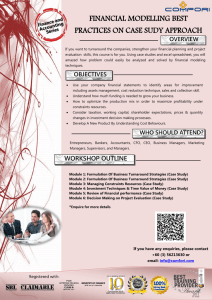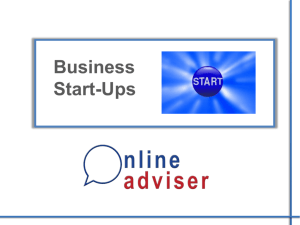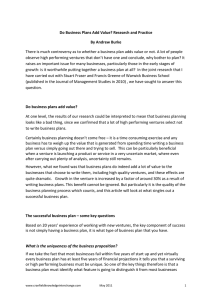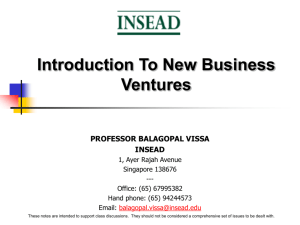Chapter 12 Considering New Ventures and Corporate Renewal
advertisement
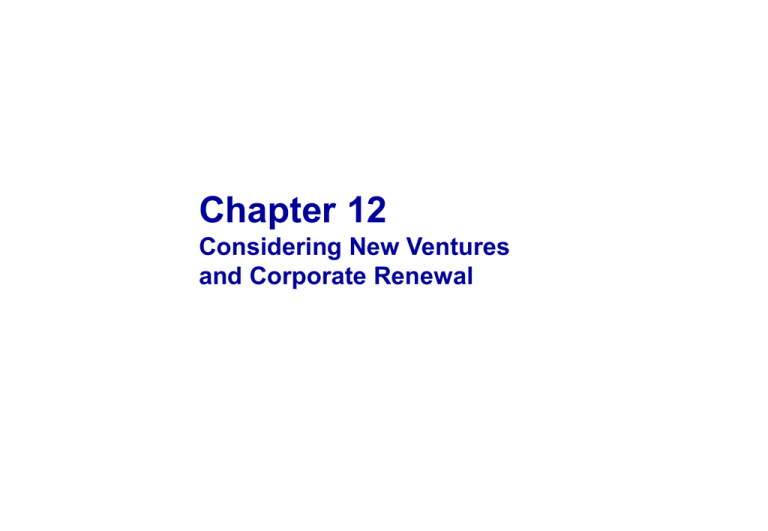
Chapter 12 Considering New Ventures and Corporate Renewal OBJECTIVES 1 Define new ventures, initial public offerings (IPOs), and corporate renewal and describe how they are related to strategic management 2 Understand entrepreneurship and the entrepreneurial process 3 Describe the steps involved in new-venture creation and corporate new venturing 4 Map out the stages leading up to an IPO 5 Understand the external and internal causes of organizational failure 6 Outline an action plan for strategic change and corporate renewal 1 SNOCAP AND NAPSTER With the music industry experiencing major changes, the old business models were disintegrating as numerous new models were being developed. 2 ENTREPRENEURSHIP AT JONES SODA Innovative products • Turkey and gravy flavored • Urban Juice and Soda Co. born in Vancouver, Canada in 1987 by a former sky instructor • soda Jones WhoopAss energy drink Jones Naturals juices Innovative practices • Unique venues (e.g., sky • • $27 million in sales • Trade over the • counter (OTC) Possible acquisition target shops, tattoo parlors) Outsourced distribution (e.g., contract packers, independent trucking companies) 3 JONES SODA FINANCIALS AT A GLANCE 2004 2003 2002 2001 27.5 20.1 18.6 23.3 Net income ($ millions) 1.3 0.3 (1.2) (1.7) Employees 51 Sales ($ millions) Headquarters Seattle, Washington Top management team Peter Van Stolk, CEO Jennifer Cue, COO & CFO 4 ORTHODOXIES DEVELOP ALONG SEVERAL DIMENSIONS • Who the customer or end user is • The type of interface and interaction with the customer or end user • How benefit is defined and value is delivered • How product/service functionality is defined All potentially create blind spots • What form the product/service should take • How processes are structured and managed • The “ideal” cost and pricing structure 5 SOME ORTHODOXIES THAT HAVE CREATED BLIND SPOTS “This ’telephone’ has too many shortcomings to be seriously considered as a means of communication. The device is inherently of no value to us” – Western Union internal memo, 1876 “The wireless music box has no imaginable commercial value. Who would pay for a message sent to nobody in particular?” – David Sarnhoff’s associates in response to his urgings for investment in the radio in the 1920’s There is no reason anyone would want a computer in their home” – Ken Olson, President, Chairman and Founder of Digital Equipment Corp., 1977 “The concept is interesting and well-formed, but in order to earn better than a ‘C’, the idea must be feasible” – A Yale University management professor in response to Fred Smith’s paper proposing reliable overnight delivery service. Smith went on to found Federal Express Corp “A cookie store is a bad idea. Besides, the market research reports say America likes crispy cookies, not soft and chewy cookies like you make” – Response to Debbi Field’s idea of starting Mrs. Field’s Cookies “There will never be a market in selling stock over the internet” – David Komansky, Merrill Lynch Chairman & CEO, 1999 6 THE ENTREPRENEURIAL PROCESS Resources and capabilities Opportunity Entrepreneur and entrepreneurial team 7 STARTING POINT Strategies for Existing Firms New Ventures Resources and capabilities Opportunity Resources and capabilities Opportunity Entrepreneur and entrepreneurial team Entrepreneur and entrepreneurial team New ventures start with an opportunity While strategy for existing firms begins with the assessment of resources and capabilities 8 ACTIVITIES IN NEW VENTURE CREATION Idea Business Plan External Financing Opportunity New Product Launch 9 THE BUSINESS PLAN Contents 1. Executive summary: One to three pages highlighting all key points in a way that captures the interest of the reader. Stress the business concept here, not the numbers. It is the unique value proposition and business model that really matter 2. Company description: Provide a brief description of the company’s business, organization, structure and strategy. Provide a summary of how the company’s patents or licenses to patents are connected with the development and introduction of products 3. Products and services: Include a layman’s overview of how the company’s technology and patents relate to its products and services. Describe the products or services the company will sell, including a discussion of why people will want them, what problems they solve, and how much customers are likely to pay for them (i.e., the willingness to pay criteria) 4. Market analysis: Identifies the need for the product, the extent of that need, who the customers will be, and why they will buy your product. This section should also include a discussion of competitors or potential competitors and why the product will have a competitive advantage over their offerings. Include considerations of barriers to entry in this market 5. Proprietary position: If the new venture’s market position will rely on patents or licenses to patents, discuss how these patents will contribute to the company’s competitive position and whether other patents (competitors or otherwise) might limit the company’s ability to market its products. If similar products do not already exist, discuss the alternative means by which customers are likely to meet the needs the product addresses 6. Marketing and sales plan: Show how the company plans to attract and maintain customers. Discuss product pricing, promotion, and positioning strategy 7. Management team: Describe the management team with special emphasis on its track record at accomplishing tasks similar to those it will face in making the company successful. Investors place major emphasis on the management team, viewing it as the critical ingredient in catalyzing the growth of the company and responding to the unexpected 8. Operations plan: Describe how the day-to-day operations of the company will be organized and carried out to produce the products and services described above 9. Finances: Identify the capital that will be required to build the business and how it will be used. Include projections of revenues and expenses that show investors how they will get their money back and what return they can expect on their investment • Brings together all elements of venture • Ensures stakeholder (e.g., investors) of venture plan • Forces entrepreneur to examine all facets of strategy 10 CORPORATE NEW VENTURING – NEW VENTURE CREATION BY AN ESTABLISHED FIRM Established firm Idea New venture Companies that do this well include • • • • • • • • • • Merck 3M Motorola Rubbermaid Johnson & Johnson Corning General Electric Raychem HP Wal-Mart 11 THREE OBSTACLES CORPORATE NEW VENTURES FACE Too many lavish resources on new ventures Try to mitigate false starts and failures so miss out on learning experiences Resist challenging assumptions, work practices, and skills 12 NEW VENTURE DIVISIONS AND BUSINESS INCUBATORS Existing Firm Incubator New venture Process Product Technology 13 CORPORATE NEW VENTURES ARE MORE LIKELY TO SUCCEED WHEN… Developed in firms with supportive climates Test concepts with potential users Have senior sponsorship Experiment repeatedly Based on related products Balance profitability with time lines Appeal to an emerging subset of customers Don’t introduce too early Employ market-experienced people Combine disciplined oversight with autonomy 14 THE INITIAL PUBLIC OFFERING (IPO) 2 Hire investment bank and estimate value of company 1 Company decides it wants to tap public markets for investment capital 3 File S-1 statement with SEC and other security commissions 4 Prepare and distribute investor prospectus 5 Price and sell share (“Go public”) 15 MINIMUM COSTS OF GOING PUBLIC TO RAISE $25 MILLION Pre-IPO costs over two years, 1. 2. 3. Upgrading accounting and MIS New personnel and board members Management/administrative time 150,000 150,000 100,000 Minimum Pre-IPO Costs 400,000 IPO-process costs 90 days, 6.5% underwriter commission $25 million IPO IPO professional fees 1. 2. 3. 4. 5. 6. 7. Legal fees Preliminary/final prospectus printing Translation Investors relations Accounting Road show and preparations Initial stock exchange listing fee 1,625,000 150,000 100,000 30,000 40,000 50,000 50,000 10,000 Minimum IPO professional fees 430,000 Minimum IPO-Process Costs Pre-IPO costs every year thereafter, 1. Investor relations and Web site 2. Directors’ fees, travel costs, etc., 3. Directors’ liability insurance 4. Corporate image, public relations 5. Annual stock exchange fee 6. Management/administration costs 2,055,000 100,000 100,000 50,000 50,000 5,000 100,000 Minimum Annual Post IPO-COSTS Total Minimum Cost of a $25 million IPO Source: P. Downing, “IPO Launch Fraught with Perils,” The Ottawa Citizen, High-Tech Report, October 12, 1998 405,000 2,860,000 16 CORPORATIONS FAIL FROM FORESEEABLE EVENTS A study of 51 failed organizations reveal ... ... they failed from foreseeable events Cause of failure Foreseeable 51 Not foreseeable 0 Source: S. Finkelstein, why smart executives fail (New York: Portfolio press, 2003) 17 EXTERNAL CAUSES OF FAILURE Economic change Competitive change External Social change Failure Technological change Internal 18 INTERNAL CAUSES OF FAILURE External Failure Strategy failure Internal Management failure 19 STRATEGIC CHANGE Significant changes in resource-allocation choices or business activities that align the firm’s strategy with its vision, or changes to the firm’s vision 20 STRATEGIC CHANGE Cost reduction Asset reduction Restructuring Sometimes requires short-term reduction in staffing or the elimination of expenses Identify assets that may be undervalued on the books and then sold to realize their true market value Major change in the composition of a firm’s assets; usually involves selling off businesses 21 EIGHT STEPS TO TRANSFORMING YOUR ORGANIZATION 1. Establishing a sense of urgency 2. Forming a powerful guiding coalition 3. Creating a vision 4. Communicating the vision 5. Empowering others to act on the vision 6. Planning for and creating short-term wins 7. Consolidating improvements and producing still more change 8. Institutionalizing new approaches 22 THE CHANGE PROCESS Communicate Vision Skills Incentives Resources Structure Execution Plan Strategic Change Skills Incentives Resources Structure Execution Plan Confusion Incentives Resources Structure Execution Plan Stress Resources Structure Execution Plan Gradual Change Structure Execution Plan Frustration Execution Plan Conflict Skills Skills Incentives Skills Incentives Resources Skills Incentives Resources Source: A. Marcus, Management Strategy (New York: McGraw-Hill, 2004) Structure Chaos 23 TURNAROUND CAVEATS TO BEAR IN MIND 1 Because every turnaround is unique, each stage is not necessarily distinguishable in every turnaround 2 The number of stages involved in each turnaround stage will depend on the seriousness of the financial crisis facing a given company. The more dire the trouble, the more stages the turnaround process will likely involve 3 The importance of each stage will vary from case to case. Sometimes, for instance, analysis will be more important than action, whereas the opposite will be true in other cases 4 A company can find itself involved in more than one stage at a time. Stages can overlap, and some tasks may affect more than one stage 5 The length of time required to address each stage is not only fluid but can vary greatly. The major factors in determining the amount of time entailed by each stage include the size of the company and the severity of its financial straits. Addressing every stage in the process may take 12 to 36 months 24 STAGES IN THE TURNAROUND PROCESS Stages Objectives and Action Items Management Change Evaluation Emergency Stabilization Return-toNormal • Select new • Can it • Survival • Enhance • Seek top management team • Weed out impediments • Select a turnaround survive? • Identify strategy • Develop profitability • Positive cash • Restructure flow business to increase ROI profitable growth • Build competitive strengths • Raise cash plan • Determine • Take charge nature of turnaround • Get control of cash Source: Adapted from Thomas D. Hays, III, CTP, Certified Turnaround Professional, Nachman Hays Brownstein 25

